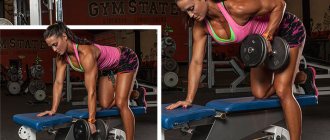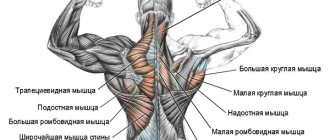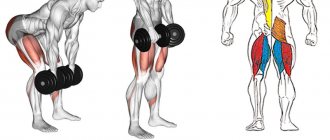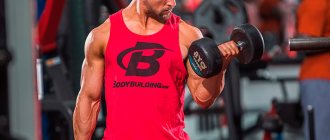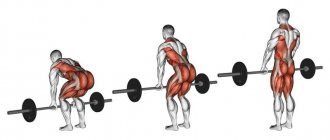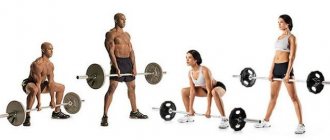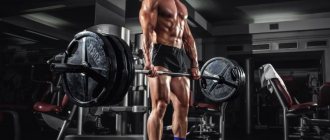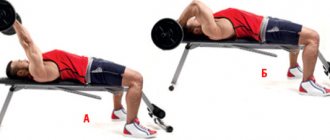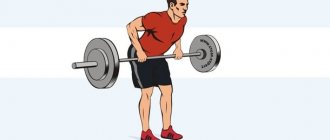Technique and types of exercises
There are two options for traction: two hands and one. Each of these options has its own variations. In any of them, always keep your back straight and your lower back slightly arched. Make movements without jerking. The standard grip is neutral. Palms facing the thigh.
With two hands
It is performed in a standing position, with the torso tilted parallel to the floor or at an angle of 45 degrees (as with barbell rows). Knees slightly bent. Hands with dumbbells are perpendicular to the floor.
As you exhale, pull the projectiles towards your stomach. The shoulders and forearms are pressed to the body.
Smoothly lower the dumbbells down. Feel the stretch in your back muscles, but do not relax them.
Lying on an incline bench
You rest your front body on the bench and your feet on the floor. Tilt angle 25-35 degrees. The head is directed forward, do not turn it to the side. Hands are perpendicular to the floor.
As you exhale, pull the projectiles towards your stomach. Elbows move back.
As you inhale, lower the projectiles down. However, they should not touch the floor.
This option is good for weak lower back. The load from the spinal column is transferred to the bench. You can also use more weight without worrying about your back.
One hand with emphasis on the bench
The load on the spine is slightly less than when pulling with two hands. There are three ways to do it.
First. When pumping the right side, rest your left knee and left palm on the bench. There is a slight bend in the elbow joint so that the back is almost parallel to the floor. The right leg is straight and set slightly to the side and back.
Second way. Only the left palm rests on the bench, and both feet are on the floor. To ensure the desired tilt of the body, there is a slight bend in the elbow. The left leg is put forward and also bent.
The third method is similar to the first, but the bench is not located horizontally, but at an angle of 25-35 degrees. Well suited for people with poor stretching, when it is difficult to keep your back straight when parallel to the floor.
For convenience, place the dumbbell on the bench in advance. The movements are performed as follows:
- Take a dumbbell in your working hand.
- As you exhale, gently pull the dumbbell to your lower abdomen (closer to your waist).
- The hand moves up and back, as if sliding along the body.
- At the top point, squeeze your shoulder blades together.
- As you inhale, lower the projectile to the bottom position.
Benefits and disadvantages
The exercises are energy intensive and can build strength and size in most back muscles. This will also be a great exercise for both men and women. The deadlift involves not only the back muscles, but also the central stabilizers. This type of row can also be performed on an incline bench. This provides the most stable position, reducing stress and the possibility of injury.
By changing the hold of the dumbbells (pressing your elbows to the body or like a barbell, spreading your elbows to the sides), you can change the emphasis of the load on one or another area of the back.
- In the elbows-out position, the load falls on the trapezius, teres major and minor, the back of the deltoid muscles and, of course, the rhomboid and latissimus dorsi muscles.
- When pressing your elbows to your body, the rhomboid and latissimus muscles receive the greatest load, while the remaining muscles are less loaded.
Lack of traction on the belt is a load on the spine. And athletes with injuries are not recommended to perform this exercise at all. Another thing is the incline bench press or deadlift with a T-bar. This option will suit almost everyone.
Barbell or dumbbell rows - what to choose
Dumbbells are better than barbells in the following ways:
- You can better pump your back by increasing your range of motion. When working with a barbell, the bar rests on your stomach and does not allow you to fully contract the muscles.
- Dumbbells can be pulled with one hand. It is much easier to monitor the technique on one side than on both sides at once.
- When your palm rests on the bench, it is easier to keep your torso stable. The load on the spine is also reduced.
- With dumbbells, you can exercise while lying on your stomach on a bench without risking your back health.
The downside is that with one-arm rows, the set takes twice as long to complete. You must first do all the repetitions on one side, and then the same number on the other.
If you experience severe discomfort when standing deadlifts, stop with the dumbbell version and perform the exercise with support on a bench or lying on a bench.
Bent-over barbell row technique
To ensure that your back is exclusively used during deadlifts, you will need to learn the correct technique for performing the exercise. You also need to follow the step-by-step instructions exactly. Step No. 1. To begin, pick up dumbbells. Next, go to the horizontal bench. Place your right foot on the end of the bench, but only so that your foot hangs slightly. Hold the dumbbell in your left hand (neutral grip). When performing this exercise, the torso should be tilted so that it is parallel to the floor. Your back should be straight, and your arm and leg should be on the bench. There should be a stretched dumbbell in your left hand. You have taken your starting position. Step No. 2. Begin to pull the dumbbell up and slightly back towards your stomach. The hand should be kept close to the body. You need to do the exercise slowly; rushing can get in the way. You need to ensure that the muscles of the back and shoulder blades are compressed as soon as you lift the dumbbell to the end. Step No. 3. When lowering the dumbbell, straighten your arm completely. As soon as you lower the dumbbell, immediately inhale, preparing for a new set. Once you have completed the desired number of repetitions on your left arm, move on to your right.
Practical tips:
- the dumbbell should be pulled not by hand strength, but by crushing your back muscles;
- when lifting a dumbbell, raise your elbow as high as possible, but do not move it to the side;
- To prevent your back from rounding, you need to keep your head level and look forward;
- perform deadlifts in a place where there is no mirror opposite you;
- move your elbow as high as possible, almost touching your abdominal muscles;
- in order to hold a lot of weight, you will need to wear special straps or belts;
- if you need to further strengthen your grip, then for a good grip on the dumbbell you should try to keep your thumb and index finger pressed close to the dumbbell plate.
Although there is nothing complicated in the movements, however, many athletes make mistakes in this:
- move your elbows to the side;
- bend your spine;
- lowering the pelvis and head too low.
The bent over dumbbell row is a very common exercise in bodybuilding circles. Therefore, if you want to pump up your back like a bodybuilder, then you can rest assured that this exercise will help you a lot and bring the best results.
You can also read other articles:
- Dumbbell press
- Bench press
- Lunges
- Squats with a barbell on your shoulders
- Lying dumbbell fly
Example workout
Perform dumbbell rows on back day. In this case, upper and lower rows should be performed on the same day, since the first strengthen the upper back, and the second strengthen the lower back.
You can use a kettlebell instead of a dumbbell. Only because of the shifted center of gravity of the weight, you need to perform the exercise at a slower pace.
Before training, thoroughly stretch your shoulder, elbow joints, and hands, making rotational movements. It is also necessary to prepare the cardiovascular system for intense work. To do this, perform squats, running exercises or jumping rope for 5-8 minutes.
At home
- Pull-ups – 3 sets of 12 reps.
- One-arm dumbbell rows – 3 sets of 11-14 repetitions on each side.
- Deadlift – 3 to 12.
- Dumbbell rows with two hands - 3 x 12 repetitions.
In the gym
- Pull-ups or lat pull-downs – 3 to 12.
- Bent-over barbell row – 3 to 12.
- One-arm dumbbell row – 3 to 11-14.
- Lower block thrust – 3 to 12.
At the end of classes, be sure to do a cool-down consisting of stretching and relaxation exercises.
One arm bent over row
There are two options for performing this exercise:
- one-arm dumbbell row for the latissimus dorsi;
- Bent-over dumbbell rows for the rear deltoid and trapezius.
An exercise for the back allows you to work both in a strength version and in a multi-repetition version, even for those people who have back problems. When performing, the entire massif is involved, since this is one of the amplitude exercises itself, which allows you to stretch part of the back as much as possible.
For the latissimus dorsi muscles
We have a supporting leg, which places its knee on the bench. This leg is on the same side as the arm, which will also be the supporting one. The second leg, also called the shock-absorbing leg, should stand close to the bench. The exercise should stretch your back as much as possible and compress it as much as possible. Accordingly, we need the deepest amplitude. The hand moves from a point that is located under the shoulder. The supporting arm is almost straightened and rests on the bench. The dumbbell starts from a point that is the projection of the shoulder onto the floor. The dumbbell does not move straight up, but goes diagonally behind the thigh. It is important to ensure that the arm does not bend at the elbow less than 90 degrees, since the work of the biceps should be eliminated as much as possible.
The dumbbell in its normal position hangs closer to the leg, and our task is to bring it further. We lower the shoulder almost until the dumbbell touches the floor, this is the starting point, and then extend it to the outer side of the thigh, turning as much as possible. That is, the dumbbell does not move up or down, it moves in a slight arc, almost diagonally. It is important not to hold your back hunchbacked, but to still engage your lower back and maintain an arch in your back. This will allow the lower edge of the latissimus to be involved in the work from the lumbar muscles. That is, as soon as the lower back tenses, we automatically receive innervation to the lower edge of the lats. Therefore, when we pull, our entire array will work on stretching and contraction .
For the rear deltoid and trapezius
Many have seen how pros stand up to the dumbbell row, leaning in, and begin to pull. The higher we raise our torso, the more our load vector shifts from the latissimus muscle upward. In this position, the lats work more as a stabilizer rather than as a muscle that does the main work. The main muscles that will pull will be the rear deltoid and trapezius. This is, in principle, the same broach, only with an inclination. By the way, it allows you to take more weight and straighten the rear delta more powerfully.
Bent-over dumbbell row
Technique:
- we rest against the dumbbell row;
- We put our feet together;
- arch your back;
- pull higher so that the angle is more than 90 degrees;
- the elbow goes back and up.
This way we break through the rear deltoid. The exercise is very simple and quite effective, since the rear delta works in all back movements. It all depends on how your arm bends.
Tips for implementation
To achieve the desired effect from training, it is important to perform the exercises correctly, eat well and get adequate rest. The diet should include plenty of proteins and carbohydrates. The amount of fat should be kept to a minimum.
Equipment
You can use an athletic belt to support your lower back. However, there is no need to chase heavy weights. This breaks the technique of the exercise.
Shoes should be comfortable with grippy soles. If you have flat feet, use orthopedic insoles.
Fitness gloves prevent the exercise equipment from slipping out and protect your palms from the formation of calluses.
If you have discomfort in your elbow or wrist, you can use braces and bandages.
Sets and reps
In bodybuilding, to gain mass, it is recommended to perform 3-4 sets of 8-12 repetitions.
For beginners, I recommend performing 11-14 repetitions.
If your goal is to lose weight, then do 15-20 repetitions. The number of approaches is 4-5.
Dumbbell rows for powerful back muscle development
Today we will talk about one of the most effective exercises for the back - bent-over dumbbell rows. The dumbbell row is particularly powerful in developing the mid and lower back, improving lat thickness and definition (the visible separation of the muscles).
In Bent-over Dumbbell Rows, it is mainly recommended to do dumbbell rows with one leg resting on a bench. However, there is another option that is very popular among the pros. The athlete performs the exercise by holding a dumbbell rack with his free hand and bending his torso at an angle of 45 degrees (or almost parallel to the floor). This type of traction allows you to more firmly fix the position of the body and overcome a much larger working weight, and also eliminates the risk of injury to the lower back, since here it always maintains the necessary tension
In any of these variants of deadlifts, it is fundamentally important that unilateral development of the lats is used. Unilateral training promotes maximum concentration on target muscles
Execution technique. Throughout the entire range of movement of the arm, the back is kept completely straight. If, at the moment of lifting the dumbbell, your back still bends into an arc, then the weight is too heavy and needs to be reduced slightly. Another indicator of the correct working weight is the ability to lift the dumbbell as high as possible to waist level.
If you can only lift the dumbbell to hip level, you should also reduce the weight. The basis in this exercise is the full amplitude, since different muscle groups are connected here along the entire trajectory of the arm’s movement, and the more complete the amplitude, the more muscles will receive effective training. Muscles involved: latissimus, posterior deltoid, trapezius, teres major, teres minor, infraspinatus, rhomboid.
To better hold the dumbbell, you can sometimes use wrist straps, but you should not use them too often, since your forearms must develop adequate strength as the weight increases. Breathing is uniform throughout the entire exercise. Lowering the dumbbell - inhale, lifting - exhale. Negative repetitions are performed at a slow pace, positive repetitions (weight lifting) are performed with vigorous effort. As shown in photos 2 and 3, the leg (on the same side as the hand with the dumbbell) is placed slightly back to make it easier to lift the dumbbell to the top position.
Back workout:
- Pull-ups: 3-4 sets, 10 reps
- Bent-over dumbbell rows: 2 warm-up sets (each side), 12-15 reps; 3 working sets, 8-10 reps
- Seated lat pulldown: 3-4 sets, 10-12 reps
- Hyperextensions: 3 sets, 15-20 reps.
Common mistakes
- Dumbbell row to chest. The back does not work, the load goes to the deltoids. Perform rows to the waist or to the stomach.
- Lifting the projectile by turning the body. It's better to take a lighter weight, but keep your torso fixed.
- Rounding the back. Keep your back straight and your lower back arched.
- Moving your elbow to the side also reduces the effectiveness of the exercise. The elbow should move back and up. The hand seems to slide along the body.
- Tilt your head down. This makes it difficult to keep your back straight.
- Jerking movements. Lead to injury.
Now watch the video to finally consolidate your knowledge.
Now you know how to lift dumbbells correctly. That's all I have for today. Subscribe to articles and share useful information on social networks.
Basic rules for performing the exercise
In the dumbbell row, you need to take a weight that you can lift 12-15 times. We take dumbbells in our hands with a standard grip and take the starting position, that is, we bend over and turn our palms towards ourselves. It is important here to move your pelvis back as far as possible, because if you just tilt, the position for the back muscles will be unfavorable; they will experience too much stress. At this moment you will be thinking about them, and we need to work on the upper back. Therefore, we move the pelvis back so that your legs are at the level of the upper abdomen. You can also do bent-over dumbbell rows to the chest, in which case the trapezius muscles develop.
A very important point during execution. We lower ourselves until your hand is below the kneecap. We open the shoulder blades as much as possible and unfold the brush. This is the first phase of this exercise.
In the second phase, we exhale, begin to raise the shoulder blades as high as possible, and only at the top point we work with our elbows in order to contract the working muscle even better. As you move, you need to slightly supinate the hand. Don't forget that the shoulder blades work first, and then the elbows. During execution, you should not lift your head, as this prevents our trapezius muscles from contracting better. After completing the planned number of repetitions, return the dumbbells to the floor and feel how the lats have been worked.
Please note that the muscles of the lower back work in a static mode, and there should be no dynamics there. The exercise should target your upper back.
Dumbbell row lying on stomach
To work the deltoid muscles, you need to lie on a bench and lift the dumbbells alternately, as this allows you to raise them higher. As you inhale, you need to raise the dumbbell to chest level, and while exhaling, lower it to its original position.
